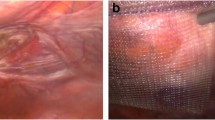Abstract
Introduction
Open tension-free hernioplasty using prosthetic meshes dramatically reduced recurrence rates after hernia or incisional hernia repair and has become the rule. Mesh infections (MI) are the major complication of prosthetic material. The aim of this study was to assess the efficacy of partial removal of mesh (PRM) therapy in the treatment of MI.
Materials and methods
From January 2000 to April 2010, from a prospective database, we retrospectively selected patients who underwent surgery for MI. We studied the epidemiological data (sex, age, obesity, diabetes, smoking), the operating time of the initial intervention, the presence of intestinal injuries during the first intervention, the average interval between initial surgical procedure and MI, the location of the hernia, the average size of the hernia, type of mesh used, the position of the mesh, type of surgery performed, the number through interventions required to achieve a cure, the cumulative duration of hospital stay and hernia recurrence rates.
Results
Twenty-five patients were supported for a MI in our institution. There were 9 women (36 %) and 16 men (64 %). The median age was 59 years (range 37–78). There were 4 inguinal hernias (16 %), 15 incisional hernias (60 %) and 6 multirecurrent incisional hernias (24 %). It was performed a PRM in 92 % of cases (n = 23), a total excision of the prosthesis in 4 % of cases (n = 1) and no removal of prosthesis in 4 % of cases (n = 1). The average number of reoperations before healing was 1 (range 1–5). The mean cumulative duration of hospitalization until healing was 9.5 days (range 2–43). No visceral resection was performed.
Conclusion
PRM is feasible in most cases allowing first to spare the capital parietal patients and secondly to avoid major surgery. In case of failure, total removal of the mesh can be discussed.

Similar content being viewed by others
References
Luijendijk RW, Hop WC, van den Tol MP, de Lange DC, Braaksma MM, IJzermans JN, Boelhouwer RU, de Vries BC, Salu MK, Wereldsma JC, Bruijninckx CM, Jeekel J (2000) A comparison of suture repair with mesh repair for incisional hernia. N Engl J Med 10; 343:392–8
Bellon JM, Bujan I, Contreras L, Juranto F (1994) Macrophage response to experimental implantation of polypropylene prostheses. Eur Surg Res 26:46–53
Sanchez-Manuel FJ, Seco-Gil JL (2009) Antibiotic prophylaxis for hernia repair. Cochrane Database Syst Rev
SFAR (2010) Antibioprophylaxie en chirurgie et médecine interventionnelle (patients adultes). Recommendations
Delikoukos S, Tzovaras G, Liakou P, Mantzos F, HatzitheoWlou C (2007) Late-onset deep mesh infection after inguinal hernia repair. Hernia 11:15–17
Fawole AS, Chaparala RP, Ambrose NS (2005) Fate of the inguinal hernia following removal of infected prosthetic mesh. Hernia 10:58–61
Johanet H, Contival N (2011) Deep mesh infection and cure of inguinal hernia. J Visc Surg (in press)
Szczerba SR, Dumanian GA (2003) Definitive surgical treatment of infected or exposed ventral hernia mesh. Ann Surg 237:437–441
Larochelle M, Hyman N, Gruppi L, Osler T (2011) Diminishing surgical site infections after colorectal surgery with surgical care improvement project: is it time to move on? Dis Colon Rectum 54:394–400
Stoppa R (2005) About prosthetic repair and contaminated areas. Hernia 9:107
Aguilar B, Chapital AB, Harold KL (2010) Conservative management of mesh-site infection in hernia repair. J Laparoendosc Adv Surg Tech A 20:249–252
Leber GE, Garb JL, Alexander AI, Reed WP (1998) Long-term complications associated with prosthetic repair of incisional hernias. Arch Surg 133:378–382
Petersen S, Henke G, Freitag M, Faulhaber A, Ludwig K (2001) Deep prosthesis infection in incisional hernia repair: predictive factors and clinical outcome. Eur J Surg 167:453–457
Trunzo JA, Ponsky JL, Jin J, Williams CP, Rosen MJ (2009) A novel approach for salvaging infected prosthetic mesh after ventral hernia repair. Hernia 13:545–549
Stremitzer S, Bachleitner-Hofmann T, Gradl B, Gruenbeck M, Bachleitner-Hofmann B, Mittlboeck M, Bergmann M (2010) Mesh graft infection following abdominal hernia repair: risk factor evaluation and strategies of mesh graft preservation. A retrospective analysis of 476 operations. World J Surg 34:1702–1709
Stoppa R, Henry X, Odimba E, Verhaeghe P, Largueche S, Myon Y (1980) Dacron tulle prothesis and biological glue in the surgical treatment of incisional hernias. Nouv Presse Med 9:3541–3545
Paton BL, Novitsky YW, Zerey M, Sing RF, Kercher KW, Heniford BT (2007) Management of infections of polytetrafluoroethylene-based mesh. Surg Inf 8:337–341
Greenberg JJ (2010) Can infected composite mesh be salvaged? Hernia 14:589–592
Author information
Authors and Affiliations
Corresponding author
Rights and permissions
About this article
Cite this article
Sabbagh, C., Verhaeghe, P., Brehant, O. et al. Partial removal of infected parietal meshes is a safe procedure. Hernia 16, 445–449 (2012). https://doi.org/10.1007/s10029-012-0931-4
Received:
Accepted:
Published:
Issue Date:
DOI: https://doi.org/10.1007/s10029-012-0931-4




